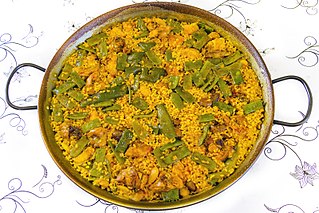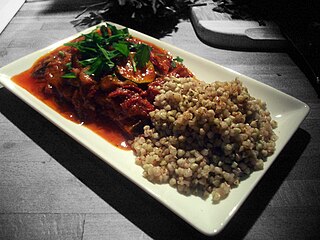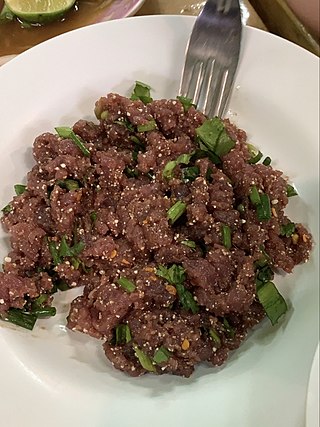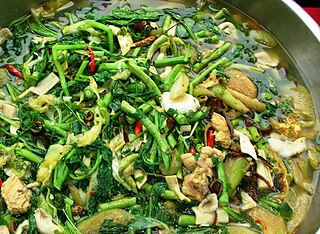
Cantonese or Guangdong cuisine, also known as Yue cuisine, is the cuisine of Guangdong province of China, particularly the provincial capital Guangzhou, and the surrounding regions in the Pearl River Delta including Hong Kong and Macau. Strictly speaking, Cantonese cuisine is the cuisine of Guangzhou or of Cantonese speakers, but it often includes the cooking styles of all the speakers of Yue Chinese languages in Guangdong.

Moroccan cuisine is the cuisine of Morocco, fueled by interactions and exchanges with many cultures and nations over the centuries. Moroccan cuisine is usually a mix of Arab, Berber, Andalusi, and Mediterranean cuisines, with minimal European and sub-Saharan influences. Like the rest of the Maghrebi cuisine, Moroccan cuisine has more in common with Middle Eastern cuisine than with the rest of Africa.

Paella is a rice dish originally from the Valencian Community. Paella is regarded as one of the community's identifying symbols. It is one of the best-known dishes in Spanish cuisine.

Maghreb cuisine is the cooking of the Maghreb region, the northwesternmost part of Africa along the Mediterranean Sea, consisting of the countries of Algeria, Libya, Mauritania, Morocco, and Tunisia. Well-known dishes from the region include couscous, pastilla, tajine and shakshouka.

Thai curry is a dish in Thai cuisine made from curry paste, coconut milk or water, meat, seafood, vegetables or fruit, and herbs. Curries in Thailand mainly differ from the curries in India in their use of ingredients such as fresh rhizomes, herbs, and aromatic leaves over a mix of dried spices.

Split peas are an agricultural or culinary preparation consisting of the dried, peeled and split seeds of Pisum sativum, the pea.

Sephardic Jewish cuisine is an assortment of cooking traditions that developed among the Sephardi Jews.

Tunisian cuisine, the cuisine of Tunisia, consists of the cooking traditions, ingredients, recipes and techniques developed in Tunisia since antiquity. It is mainly a blend of Mediterranean and native Punics-Berber cuisine. Historically, Tunisian cuisine witnessed influence and exchanges with many cultures and nations like Italians, Andalusians, French and Arabs.

Ratatouille is a French Provençal dish of stewed vegetables that originated in Nice and is sometimes referred to as ratatouille niçoise. Recipes and cooking times differ widely, but common ingredients include tomato, garlic, onion, courgette (zucchini), aubergine, capsicum, and some combination of leafy green herbs common to the region, such as chives or fennel.

Buchimgae (부침개), or Korean pancake, refers broadly to any type of pan-fried ingredients soaked in egg or a batter mixed with other ingredients. More specifically, it is a dish made by pan-frying a thick batter mixed with egg and other ingredients until a thin flat pancake-shaped fritter is formed.

The cuisine of Equatorial Guinea is a blend of the cuisines of the native peoples of this African country, including the Annobonese, the Bubi, the Fang, and the Kombe. It is also influenced by the cuisines of Spain ; other African nations such as Nigeria and Cameroon; Islamic states such as Morocco; and Creole cuisine overall. Its cuisine incorporates various meats, including game and bushmeat as well as imports, and is known for its strong flavors and high spice levels. Fish and chicken are common dishes.

Luosifen is a Chinese noodle soup and specialty of Liuzhou, Guangxi. The dish consists of rice noodles boiled and served in a soup. The stock that forms the soup is made by stewing river snails and pork bones for several hours with black cardamom, fennel seed, dried tangerine peel, cassia bark, cloves, white pepper, bay leaf, licorice root, sand ginger, and star anise. It usually does not contain snail meat, but it is instead served with pickled bamboo shoot, pickled green beans, shredded wood ear, fu zhu, fresh green vegetables, peanuts, and chili oil added to the soup. Diners can also add chili, green onions, white vinegar, and green peppers to suit their taste.

Ivorian cuisine is the traditional cuisine of Côte d'Ivoire, or the Ivory Coast, and is based on tubers, grains, pig, chicken, seafood, fish, fresh fruits, vegetables and spices. It is very similar to that of neighboring countries in West Africa. Common staple foods include grains and tubers. Côte d'Ivoire is one of the largest cocoa producers in the world and also produces palm oil and coffee.

Koi is a "salad" dish of the Lao people living in modern-day Laos and Isan, Thailand, consisting of raw meat denatured by acidity, usually from lime juice. Common varieties include koi kung, with shrimp as the main ingredient, and koi paa /koi pla, which consists of minced or finely chopped raw fish in spicy salad dressing.

Bún ốc is a Vietnamese dish originating from Hanoi, Vietnam. Roasted or boiled snails, may be eaten first as an appetizer. Snail congee is called cháo ốc, and canh ốc chuối đậu, is a thin snail soup with green banana, fried tofu and tía tô.

Kaeng khae is a curry of northern Thai cuisine.

Besan or gram flower is a pulse flour made from chana dal or chickpea flour or brown/kaala chana, a chickpea. It is a staple ingredient in the cuisines of the Indian subcontinent, including Indian, Bangladeshi, Burmese, Nepali, Pakistani, Sri Lankan and Caribbean cuisines.
Taktouka is a traditional Moroccan savory dish and spread made from tomatoes, bell peppers, garlic, toasted paprika and olive oil. Taktouka is an extremely popular dish and can be found in many restaurant in different parts of Morocco.
Bissara, bessara, besarah and tamarakt is a dish in Egyptian cuisine and Moroccan cuisine. The dish contains split fava beans, onions, garlic, fresh aromatic herbs and spices. All ingredients are slowly cooked and then blended together to yield a creamy and fragrant dip or side dish.

















